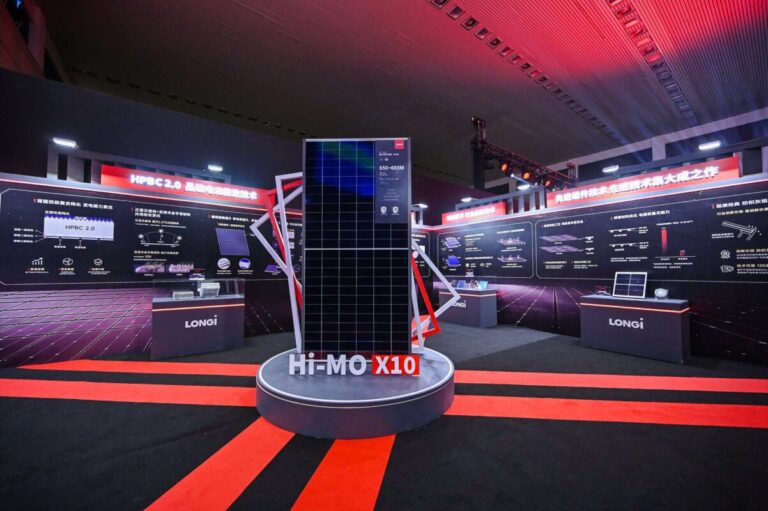LONGi introduced its next generation back contact modules earlier in October using its proprietary HPBC 2.0 cell technology with a mass production power of 670W. It claims a module efficiency of up to 24.8%, which the company claims is the global record for mass production power. module efficiency for back-contact modules would break. Thanks to the popular module size of 2,382 mm x 1,134 mm, it performs 30 W better than conventional TOPCon modules.
Focused on the distributed generation segment, the Hi-MO X10 is designed to maximize reliabilitycost-effectiveness and long-term performance.
Key Hi-MO X10 parameters:
1. The use of high-quality n-type TaiRay silicon wafers results in high resistance distribution, good impurity capture and stronger mechanical properties – all thanks to an improved Czochralski process. According to LONGi, the patented TaiRay wafer solves the long-standing challenges of silicon wafer limitations. With an improved resistivity distribution, fewer impurities and a remarkable 16% increase in fracture resistance, this wafer is said to be a key driver of the Hi-MO X10’s high performance.
2. The power temperature coefficient of -0.26%/°C delivers a 0.03% improvement over TOPCon modules and ensures reliable performance in hot and humid climates, according to the company. It exhibits a degradation of 1% in the first year and decays linearly at 0.35% over the remaining 29 years, based on the 30-year product performance warranty.
3. The zero rail structure (0BB) means that the modules have no rails on the front and back. Connecting the ribbons directly to the fingers reduces the energy transfer distance by 6.5%, adding an additional 5W to the module’s output power. Precise laser etching and advanced, highly transparent insulation materials further improve performance by reducing the risk of leakage and improving light absorption.
4. A new multi-layer structure with three components: a light absorption layer with an anti-reflection film that improves short-circuit current by 2.25% and reduces short-wave reflections by more than 12%, effectively capturing more sunlight; a photovoltaic conversion layer that uses a patented “Bipolar Hybrid Passivation Technology” that increases the open-circuit voltage by 15 mV to 745 mV and significantly reduces UV-induced degradation while increasing long-term efficiency; and an electrical transmission layer with a “Soft Breakdown Design+” and low-resistance bipolar passivation contacts. The latter would reduce shading power loss by more than 70% and reduce hotspot temperatures by 28%.
The company’s commitment to improving back contact technology is rooted in the beliefs of LONGi Chairman Baoshen Zhong, who last year repeatedly expressed confidence in the future of BC technology. “We believe that back-contact technology will become the dominant force in crystalline silicon cells, including both bifacial and monofacial designs,” he said in a company statement.
In May 2024, LONGi announced a world record photovoltaic conversion efficiency of 27.3% for its new silicon heterojunction back-contact (HBC) solar cells, certified by the Institute for Solar Energy Research Hamelin (ISFH). On October 24, the company announced another world record efficiency of 25.4% for crystalline silicon solar modules based on its HPBC 2.0 cell platform. The efficiency results have been certified by the German research institute Fraunhofer ISE. With this record, LONGi declared that it has broken the 36-year monopoly of overseas PV brands.
LONGi’s UK & Ireland General Manager Ross Kent stated that the technology and design of the evolved Hi-MO X10 would provide excellent reliability with minimal deterioration over time, ensuring long-lasting performance. Levelized Cost of Energy (LCOE) would be significantly reduced for customers. According to LONGi, the Hi-MO X10 stands as a beacon of superior efficiency.
LONGi says it has upgraded HPBC 1.0 to HPBC 2.0 in two years, with a cumulative investment of more than RMB 2 billion in R&D efforts and a high-level R&D team of more than 1,000 people. It now holds nearly 200 BC technology patents.
In Europe, the X10 will be phased in from the fourth quarter of 2024, with GW-scale mass production planned for the first quarter of 2025.
Investing in wafer improvement benefits the entire PV industry
LONGi claims that its proprietary product, the TaiRay wafer, addresses and solves the persistent problems associated with the traditional limitations of silicon wafers. These limitations may include factors such as wafer thickness, material defects, or manufacturing inefficiencies that have historically hindered the performance and cost-effectiveness of silicon wafers in solar cells. In essence, the TaiRay wafer would be an innovative solution that overcomes these technical barriers.
The M11 TaiRay wafer size is said to reduce industrial chain costs, engineering costs and module transportation costs due to improved container utilization during transportation and system cost balance (BOS). Downstream risks would also have been reduced. For example, the 72-cell version of the X10 can reduce transportation costs by $0.61/kW compared to the previous Hi-MO .5%, the company said.
As a result of the performance improvement, system cost (BOS) on the system installation side is also reduced by 3.57% (approximately $4.16/kW) compared to the equivalent mainstream power classes. Customer sales are said to increase compared to using 210R wafer-based modules. Ross Kent commented: “The ”


